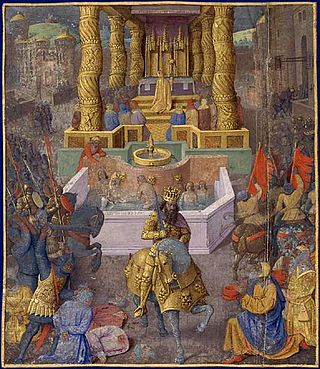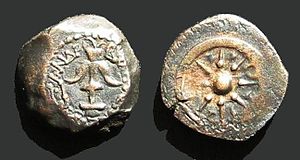
Alexander Jannaeus was the second king of the Hasmonean dynasty, who ruled over an expanding kingdom of Judaea from 103 to 76 BCE. A son of John Hyrcanus, he inherited the throne from his brother Aristobulus I, and married his brother's widow, Queen Salome Alexandra. From his conquests to expand the kingdom to a bloody civil war, Alexander's reign has been generalised as cruel and oppressive with never-ending conflict. The major historical sources of Alexander's life are Josephus's Antiquities of the Jews and The Jewish War.

The Maccabees, also spelled Machabees, were a group of Jewish rebel warriors who took control of Judea, which at the time was part of the Seleucid Empire. They founded the Hasmonean dynasty, which ruled from 167 to 37 BCE, being a fully independent kingdom from 104 to 63 BCE. They reasserted the Jewish religion, expanded the boundaries of Judea by conquest, and reduced the influence of Hellenism and Hellenistic Judaism.

The Hasmonean dynasty was a ruling dynasty of Judea and surrounding regions during the Hellenistic times of the Second Temple period, from c. 140 BCE to 37 BCE. Between c. 140 and c. 116 BCE the dynasty ruled Judea semi-autonomously in the Seleucid Empire, and from roughly 110 BCE, with the empire disintegrating, Judea gained further autonomy and expanded into the neighboring regions of Perea, Samaria, Idumea, Galilee, and Iturea. The Hasmonean rulers took the Greek title basileus ("king") as the kingdom became a regional power for several decades. Forces of the Roman Republic intervened in the Hasmonean Civil War in 63 BCE and made it into a client state, marking the decline of Hasmonean dynasty; Herod the Great displaced the last reigning Hasmonean client-ruler in 37 BCE.

Antipater I the Idumaean was the founder of the Herodian Dynasty and father of Herod the Great. According to Josephus, he was the son of Antipas and had formerly held that name.

John Hyrcanus was a Hasmonean (Maccabean) leader and Jewish high priest of the 2nd century BCE. In rabbinic literature he is often referred to as Yoḥanan Cohen Gadol, "John the High Priest".

Salome Alexandra, or Shlomtzion, was one of only three women to rule over Judea, the other two being Athaliah and Deborah. The wife of Aristobulus I, and afterward of Alexander Jannaeus, she was the last regnant queen of Judea, and the last ruler of Judea to die as the sovereign of an independent kingdom.

Judah Aristobulus I or Aristobulus I was High Priest of Israel and the first Hasmonean king of Judaea, reigning from 104 BCE until his death. He was the eldest of the five sons of John Hyrcanus, the previous leader. The Roman–Jewish historian Josephus states that he was the first Jew in "four hundred and eighty-three years and three months" to have established a monarchy since the return from the Babylonian captivity. Aristobulus was the first Hebrew king to claim both the high priesthood and the kingship. The Sadducees and the Essenes were not concerned about Aristobulus taking the title of king, but the Pharisees, believing that the kingship could only be held by the descendants of the Davidic line, strongly opposed this. They launched a massive rebellion, but Aristobulus died before any attempt to depose him could happen.

Aristobulus II was the Jewish High Priest and King of Judea, 66 BCE to 63 BCE, from the Hasmonean dynasty.

John Hyrcanus II, a member of the Hasmonean dynasty, was for a long time the Jewish High Priest in the 1st century BCE. He was also briefly King of Judea 67–66 BCE and then the ethnarch (ruler) of Judea, probably over the period 47–40 BCE.

Antigonus II Mattathias, also known as Antigonus the Hasmonean was the last Hasmonean king of Judea. He was the son of King Aristobulus II of Judea. In 37 BCE Herod handed him over to the Romans for execution, after Antigonus's three-year reign during which he led the Jews' fierce struggle for independence against the Romans.

The Teacher of Righteousness is a mysterious figure found in some of the Dead Sea Scrolls at Qumran, most prominently in the Damascus Document. This document speaks briefly of the origins of the sect, probably Essenes, 390 years after the reign of Nebuchadnezzar and after 20 years of looking blindly for the way. "God... raised for them a Teacher of Righteousness to guide them in the way of His heart".

Mariamne I, also called Mariamne the Hasmonean, was a Hasmonean princess and the second wife of Herod the Great. Her parents, Alexandra Maccabeus and Alexander of Judaea, were cousins who both descended from Alexander Jannaeus. She was known for her great beauty, as was her brother Aristobulus III. Herod's fear of his Hasmonean rivals led him to execute all of the prominent members of the family, including Mariamne.
The procuratorial coinage of Roman Judaea was minted by the prefects and procurators of the province between AD 6 and 66 in only one denomination and size, the bronze prutah.

Prutah is a Hebrew term, possibly derived from Aramaic. It refers to a small denomination coin.

First Jewish Revolt coinage was issued by the Jews after the Zealots captured Jerusalem and the Jewish Temple from the Romans in 66 CE at the beginning of the First Jewish Revolt. The Jewish leaders of the revolt minted their own coins to emphasize their newly obtained independence from Rome.
Herodian coinage were coins minted and issued by the Herodian Dynasty, Jews of Idumean descent who ruled the province of Judaea between 37 BC–92 AD. The dynasty was founded by Herod the Great who was the son of Antipater, a powerful official under the Hasmonean King Hyrcanus II.

The Second Temple period or post-exilic period in Jewish history denotes the approximately 600 years during which the Second Temple stood in the city of Jerusalem. It began with the return to Zion and subsequent reconstruction of the Temple in Jerusalem, and ended with the First Jewish–Roman War and the Roman siege of Jerusalem.

The Herodian kingdom was a client state of the Roman Republic ruled from 37 to 4 BC by Herod the Great, who was appointed "King of the Jews" by the Roman Senate. When Herod died, the kingdom was divided among his sons into the Herodian Tetrarchy.

Herod the Great's siege of Jerusalem was the final step in his campaign to secure the throne of Judea. Aided by Roman forces provided by Marcus Antonius, Herod was able to capture the city and depose Antigonus II Mattathias, ending Hasmonean rule. The siege appears in the writings of Josephus and Dio Cassius.


















